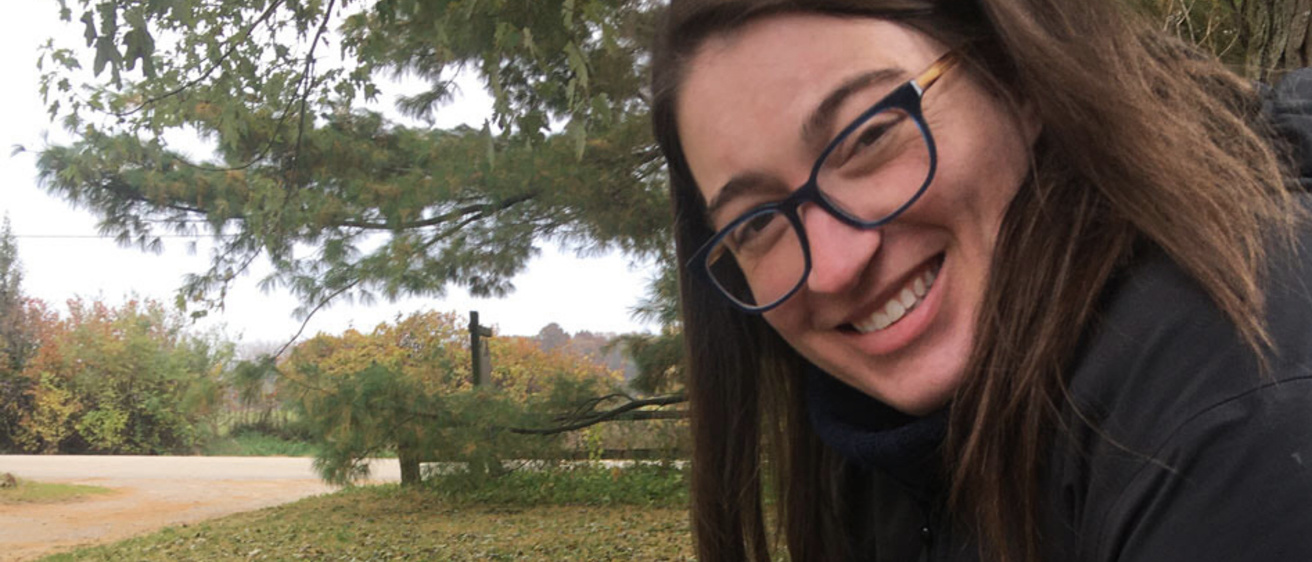Laura Perry is joining the Obermann Center staff for the next two years as a Mellon Postdoctoral Fellow with the Humanities for the Public Good project. Born in Southern California, Laura recently received her doctoral degree in Literary Studies from the University of Wisconsin-Madison. In addition to serving as the managing editor of the digital magazine Edge Effects, she was a project assistant for the research group “Environmental Justice in Multispecies Worlds,” a 2017-19 Mellon-Morgridge Constellations Fellow, a radio show host at WSUM 91.7 FM, and a Public Humanities Exchange (HEX) Fellow in partnership with local nonprofit Sheltering Animals of Abuse Victims. She spoke with Jennifer New, associate director of the Obermann Center, about her scholarly interests and what drew her to work with HPG.
We love to help our post-docs find other scholars and community members with a shared interest. Could you tell us about your current research?
I’m interested in the American suburbs and why neighborhoods are the way they are. The suburbs are such a large part of our national landscape and imagination. Just think about the frequent dog whistles of American political rhetoric, “suburban housewives” and “suburban voters.” I defended my dissertation a little over a year ago and I’m now adapting it into a book, tentatively titled The Nuisance: A Cultural History. My dissertation was focused on literature, because I was in an English department, but during my research I found myself constantly pulled outside of this disciplinary lens towards other approaches to the suburbs, like environmental and social justice movements, urban planning, and environmental sciences.
The project is about who and what becomes a nuisance and why. In the early 20th century, the idea of a nuisance was primarily a legal tool to curb industrial pollution, like runoff from slaughterhouses and factories. By the 1940s, however, nuisances became more than just environmental hazards. Suburban homeowners, and others, appealed to the idea of a nuisance to define who and what belonged in the suburbs, and who and what didn’t. Some looking at a suburban neighborhood might accept it at face value and imagine that it developed organically or by happenstance. But there are so many reasons why the suburbs are how they are, from zoning to redlining to racist violence. These federal, state, and local efforts to define the suburbs depend on defining nuisances—who and what doesn’t belong— and continue to shape American neighborhoods in harmful, unjust, racist, and classist ways today.
You were the managing editor of Edge Effects, a digital magazine produced by graduate students in the Center for Culture, History, and Environment at the University of Wisconsin-Madison. How did this experience impact your academic career and your ideas about graduate education?
The name of the magazine comes from ecology; an edge effect is what happens when two distinct ecosystems or habitats meet, like a prairie and a marsh. The magazine publishes essays, exhibits, and podcasts about environmental and cultural change from writers and artists across many different fields and backgrounds, and aims to amplify historically marginalized voices in environmental conversations, including students, staff, activists, and those outside the academy. The editorial team has graduate students from geography, agroecology, biology, literary studies, environmental history, and more. This interdisciplinary community was invaluable in breaking down the silos of a large campus and allowing me to meet other students with shared commitments who I might never have known otherwise.
My three years of working at Edge Effects helped me to figure out what I want in a career: the opportunity to collaborate. Prior to joining the editorial board, graduate school was a very solitary experience. I was reading books that no one else I knew had read. In some ways, that’s exciting. You really burrow into a subject. But it’s also very isolating. With the magazine, though, I was part of a team of people dedicated to the same values, including equity in academia, interdisciplinary scholarship, and environmental justice. I loved learning with people—my fellow editors as well as the writers and artists I worked with to publish pieces.
What especially excites you about working with Humanities for the Public Good?
I am so excited to work with such a collaborative team, and have the chance to brainstorm about the future of graduate education. The initiative’s focus on campus-community partnerships and graduate internships is especially exciting to me. I am so deeply convinced of the worth and possibility of those opportunities for grad students, programs, and organizations. Some of my most cherished, and educational, experiences in graduate school happened because of partnerships with local organizations, as a teacher, a student, and a volunteer. And I’m also especially excited about that aspect of the grant because of how squarely, and tangibly, those connections can be focused on the public good. I can’t wait to learn from and work alongside local communities and organizations.
You’re still up in Madison until we are able to work together in person. Once you’re able to move to Iowa City, what are you looking forward to?
I’ve never been to Iowa City, but I’ve heard such wonderful things about the city and the community. Among many other things, I’m really looking forward to exploring the dog parks and prairies with my two dogs, Summer and Magellan.
